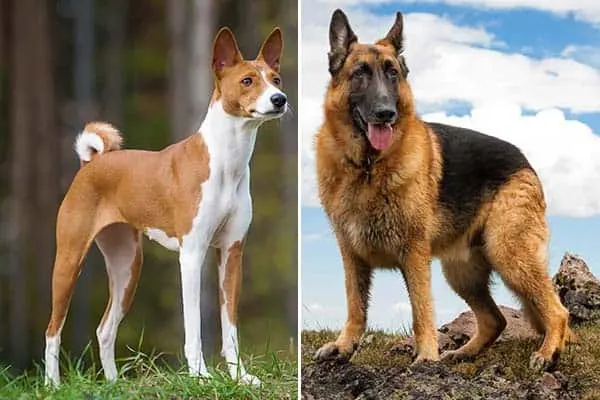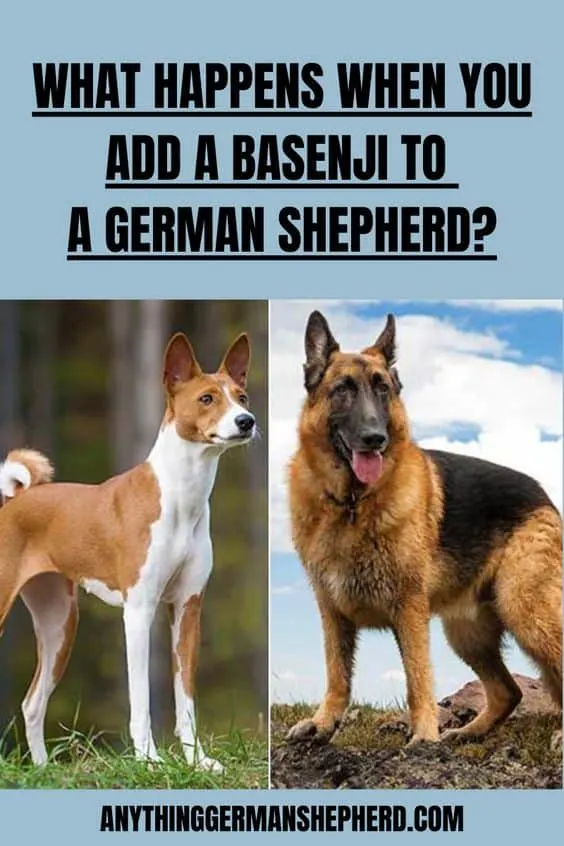What Happens When You Add a Basenji to a German Shepherd?
Do you ever shake your head and wonder why someone would want to mix two certain dog breeds? Sometimes a mix seems to defy all reasoning and sense of aesthetics.
For instance, who would even think of breeding a Basenji with a German Shepherd? What sort of dog would you get?
Despite the remarkable differences between the two breeds, a Basenji-German Shepherd mix is not as bizarre as it sounds. An ideal amalgam would give you an intelligent and athletic medium-sized tan dog with moderate-sized upright ears, perhaps a curly tail, short thick fur, and a protective presence.
However, genetics being as unpredictable as they are, let us examine the two breeds side by side and determine what characteristics may potentially end up in your puppy.

From whence did they come, and where are they now?
We want to start with the origins of the GSD and Basenji.
You have likely seen a lot of literature about German Shepherds. That would not be surprising as they are the No. 2 most popular dog as of 2018, according to AKC, and one of the most recognizable breeds.
According to German Shepherd Rescue Elite, German Shepherds originated from a stock type of the ideal working dog, Hektor, discovered and developed by Max von Stephanitz in 1899.
Stephanitz promoted function over appearance in a dog but felt a great working breed could have both ability and beauty.
Stephanitz’s theories proved correct, and his efforts paid off. The German Shepherd possesses elegance and grace and can perform almost any task.
You can see GSDs in the police force in several capacities such as drug-sniffing, bomb detection, perpetrator apprehension, and search and rescue.
They also lead the blind, act as therapy dogs, perform agility and obedience, guard people and property, serve as loyal companions, and herd.
Egyptian culture and Libyan art depicted the Basenji as early as 3000 and 6000 BC, respectively. The modern Basenji developed in what is now the Democratic Republic of the Congo among the Pygmy ancient civilizations.
According to Basenji.org, they were one of the earliest offshoots from the canine’s wolf ancestors and are most closely related to the Dingo and New Guinea Singing Dog.
Initially, early humans used Basenjis to drive wild game into nets. Basenjis also flushed and pointed small animals and kept rodent populations in check.
In more recent times, they have featured in movies, although never gaining the popularity of the German Shepherd.
Outside of the show ring, they mostly serve as unusual but loyal companions and can excel in lure courses and agility trials.
What happens when your parents look nothing alike?
The Significant Size Differential
Your GSD Basenji hybrid has a vast range of possible sizes depending upon which parent she favors. German Shepherds can be 60 to over 100 pounds, females smaller than males. Basenjis, on the other hand, are 20 to 26 pounds, with only a slight difference between the genders.
German Shepherds are 22 to 26 inches tall at the withers and Basenjis 16 to 18 inches. Where the GSD is long in the body, the Basenji is compact. Both are muscular and lean dogs.
Pick a color
We could write an entire article about color heredity in dogs; it is so complicated. The color options are extensive between the German Shepherd and Basenji.
German Shepherd
- Classic black and tan – tan with extensive black including a saddle and facial mask
- Red and tan
- Red
- Blue
- Black
- White
Basenji
- Red and white
- Black and white
- Brindle and white
- Tri-Color
- White is usually in a stereotypical pattern on the chest, legs, and varying proportions of the neck and down the front of the face.
The gap in general appearance is huge
The German Shepherd is a medium-large dog with moderate to long fur and a substantial undercoat. Basenjis are medium-small dogs with firm pliant skin developed for dense forest undergrowth.
The Basenji has short glossy hair and only grows an undercoat if the weather warrants it. Breed-defining wrinkles on the forehead give the Basenji further protection hunting in thick shrubbery.
Your puppy could inherit a tightly or semi-curled tail from the Basenji or a low-slung long bushy tail of the German Shepherd.
Both dogs have upright ears with the Basenji’s relatively broader, less tapering towards the tips, and set well forward.
The Shepherd has a sloping topline from shoulders to hips, while the Basenji is level with long legs relative to his body.
Athleticism and activity levels are more similar
While the German Shepherd is considered the most versatile of working dogs, the Basenji is a remarkable athlete.
Basenjis are powerful for their size, agile and fast with a whippet-like double-suspended gallop, and are excellent climbers. German Shepherds have impressive stamina, efficient ground-covering strides, and speed when necessary.
Since physical prowess and activity levels are so similar in the two parent breeds, exercise requirement is one of the most predictable qualities of a Basenji Shepherd mix.
A mixed puppy will need over an hour of exercise a day. Sedate walks will not be sufficient for his lively personality.

Intelligence and trainability do not always go hand in hand
According to Good Housekeeping and other lists based on the research of expert canine behaviorists, German Shepherds rank high in intelligence according to most charts. They usually reign in the top two or three with Border Collies and Poodles.
While smart, Basenjis ranked No. 78 out of 137 in trainability, according to dogbreedslist.info. With a long history of independent cooperation with their owners, Basenjis do not have an inherent desire to please.
Whether you get an obedient or uncooperative puppy is a roll of the dice when you blend the two breeds.
Both breeds require consistent training and constant mental stimulation. You can use interactive toys or activities like fetch to engage them or add puzzle games.
Additional concerns for the Basenji are her ability to scale walls to escape and her speed and disobedience off-leash.
Is the German Shepherd Basenji mix a good guard dog?
Mix the German Shepherd’s exceptional guard capacity with the Basenji’s lack of a protective background, and what will you get?
Although Basenjis are not bonafide guard dogs, they are attentive and alert and somewhat aloof with strangers. By body language, a Basenji will let you know of intruders. Some Basenjis are silent, while others will growl, whine, or yodel.
German Shepherds are uninhibited in their announcement of threats or guests.
German Shepherds can be ferocious defenders of home and family. A Basenji is not nearly as likely to bite preemptively.
However, Newslinq ranks them No. 17 on the top 25 list of dangerous dogs, so you do not want to take any warnings lightly.
Newslinq ranks dogs, like Alsatians and Basenjis, on how much damage they could potentially do if they attack, not necessarily the likelihood they would bite.
Will you have a good family dog?
A Basenji German Shepherd mix has all the qualities to be a good family dog. German Shepherds are loyal and dedicated while Basenjis are affectionate and attached. Both parent breeds tend to form deep bonds with one person over others.
Use caution around other animals
Germans Shepherds, if raised with proper socialization, can get along with other animals in the household. Their size and herding instincts, which in some manifests as prey drive, make them untrustworthy around small dogs and cats.
A solid hunting background and strong prey drive paired with their unpredictable natures around other dogs describe Basenjis. Therefore, Basenjis do best in single-animal households.
What about children?
Neither Basenjis nor German Shepherds are great around babies, so you cannot expect a mix to be ideal. Their activity levels make them better candidates for older children.
Expect moderate grooming requirements
German Shepherds require a thorough brushing at least once or twice a week to remove dead hair and dirt from the undercoat. Regular brushing of Basenjis keeps their skin healthy and coat free from debris.
Neither dog requires hair clipping.
You should bathe when you deem appropriate. German Shepherds are generally much more amenable to baths than Basenjis, who cannot stand to get their feet wet. Basenjis often groom themselves like a feline and lack the odor and shedding associated with most other dogs.
Do you want to talk about the weather?
Intuitively, German Shepherds can withstand frigid temperatures much better than Basenjis. Basenjis can handle moderately cold weather for short durations if they are in good physical condition.
German Shepherds also handle the heat surprisingly well, but Basenjis are better equipped. Your Basenji mix may not like the dampness of snow or rain.
How long will my Alsatian-African Barkless Dog mix live?
The different breeds experience divergent health issues and the resultant crosses of the two can exhibit any of them.
GSD
- Hip dysplasia
- Elbow dysplasia
- Pannus – a corneal abnormality
- Gastric dilatation and volvulus – stomach bloats then twists
- Degenerative disc disease – back issue
- Diabetes
- Cataracts
- Hemophilia – blood clotting irregularity
- Seizure disorder
Basenji
- Hip dysplasia
- Luxating patella
- Corneal dystrophy – abnormal deposits in the cornea
- Hypothyroidism – low thyroid function
- Fanconi syndrome – a type of inherited kidney disorder
- Progressive retinal atrophy – dogs eventually go blind
With a mixed breed, you may not have access to parent history, and certificates for orthopedic and eye health are not likely to exist.
According to the AKC, Basenjis live 13 to 14 years and German Shepherds 10 to 12. Other sources, such as breeders, put the lifespan of Basenjis between 12 and 16 years.
What is a Basenji German Shepherd Mix?
Ultimately, no one knows what kind of dog a mix between a German Shepherd and a Basenji will create. Temperament, for example, varies within breeds, let alone with outcrossing.
Dogs inherit colors based on a variety of factors, and you must take into account not only the dominance of genes like black or brindle but also patterns.
As you can see with Labradoodles, coat density is also a trait that litters inherit with high variability.
We can speculate about a puppy based on what we know about the parent breeds and our experience with other hybrids.
Basenji German Shepherd mixes are most likely to be loyal and affectionate dogs with a healthy suspicion of strangers.
They will be good watchdogs with a low guarding tendency. These hybrids will probably be tolerant of dogs their size, perhaps preferring those of the opposite sex.
The most common expected colors are fawn, black and tan, or red and white. Red and white dogs have markings like Basenjis and black and tans look like Shepherds. Many will have a tail that is shorter than a Shepherd’s with at least a moderate curl.
Most mixes have a skull that is flatter than a German Shepherd’s dome-shaped head with a narrower muzzle. Sizes range from a little larger than a Basenji to medium.
German Shepherd and Basenji mixes will suffer both small and large dog problems and live 11 to 14 years.
The German Shepherd-Basenji is likely to be intense, intelligent, and active. Be mindful that the hybrid bores easily and is prone to the destructiveness of its parent breeds when left alone.
We leave you with an excellent example of a German Shepherd and Basenji mix with the black and tan coloration of a Shepherd and the compact smaller size and slightly boxy head that is distinct from either of the purebreds. Note the dog’s high energy and shortened semi-curled tail.
Related Reading: German Shepherd Great Dane Mix: The Best Big Dog For A Family?






























